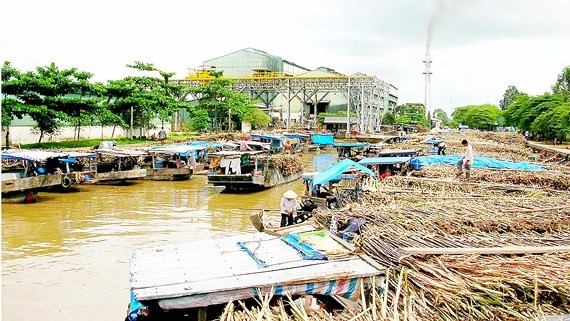
Meanwhile, thousands farmers in the Mekong Delta are in dilemma. They have continued to grow sugarcanes with the hope that they will have a bumper crop out of three lean ones. Where will sugarcanes and sugar refineries go. That will be a haunting question in the next few years.
In its heyday, there were nearly 100,000 hectares of sugarcanes in the Mekong Delta. The area of sugarcane now has been reduced to around 35,000 hectares. At the present, Phung Hiep District in Hau Giang Province is considered to have the largest sugarcane area in the Mekong Delta with 6,700 hectares (at peak time, the area of sugarcane here was nearly 15,000 hectares with production reaching 1 million tons of sugarcanes annually).
Mr. Truong Van Hien, a farmer who has been growing sugarcanes for a long time in Hiep Hung Commune in Phung Hiep District, said that he felt anxious when other farmers chopped down sugarcanes to switch to grown seedless limes but he had already mortgaged his property for previous sugarcane crops so now he does not have money to invest in growing seedless limes as well as buying fertilizers while it takes lime trees a few years to be ready to bear fruits. Therefore, he has no choices but to continue to grow sugarcane with the hope that there will be a bumper crop out of three poor ones.
Mr. Nguyen The Tu, deputy head of the Department of Agriculture and Rural Development in Phung Hiep District, said that according to the plan to 2020, the district will only keep around 5,000 hectares of sugarcanes. Currently, the district has actively provided 100 percent of seedlings for sugarcane farmers to switch to grow seedless lime trees. Moreover, the district has also encouraged farmers to grow MD2 pineapple variety. Firms have pledged to buy all these farm products.
Mr. Tu says that many farmers in the district are not able to shift to grown other crops due to financial crunch while some others are used to with growing sugarcanes so they hesitate about changing crop.
According to Mr. Tran Chi Hung, director of the Department of Agriculture and Rural Development of Hau Giang Province, agriculture has been focusing on solutions to support farmers to switch crops and only keep sugarcanes in the area with dykes so as to supply material for sugar refineries in the district.
The prices of sugarcanes and sugar declined in tandem, causing the area of sugarcanes in Ca Mau and Kien Giang provinces to continuously reduce for years. This is also the reason that made two sugar refineries in the area shut down and sell their machineries. This year’s sugarcane crop is closing with sorrow for both farmers and firms.
Earlier, there were 10 sugar refineries in the Mekong Delta but now four of them are closed. Among six remaining sugar refineries, two will possibly be unable to operate in the next crop as the area of sugarcanes is decreasing sharply. At the present, Con Long My Phat sugar refinery also has been facing several difficulties after being found to have caused serious pollution in the river in Long My Town and being inspected by inspectors from the Vietnam Environment Administration under the Ministry of Natural Resources and Environment.
Recently, the delegation from the National Assembly’s Economic Commission visited Phung Hiep District and Casuco Company to survey and understand the production situation as well as difficulties in sugar consumption lately. The representative of Casuco Company said that production of its two sugar refineries dropped in the 2018-2019 crop, down 37.7 percent in the amount of sugarcanes and 43.5 percent in the amount of sugar.
Low sugarcanes prices urged farmers to switch to grow other crops, causing high cost prices for sugar refineries so it was difficult for them to compete with imported sugar and especially with super cheap smuggled sugar. It is forecast that in the near future, its two refineries will face a shortage of material as the area of sugarcanes has been narrowed to above 6,000 hectares, equal to around 400,000 tons of material sugarcanes.
Leader of the National Assembly’s Economic Commission said that the sugar industry should determine clearly its production goal in order for local authority to plan for the material area and encourage farmers to continue to grow sugarcanes to provide enough material for production. As for the delegation, they will ask the National Assembly to have suitable policy for sugar industry to help farmers maintain sugarcane cultivation.
According to a leader in the sugar industry, closing down low capacity sugar refineries is necessary to support firms amid economic integration but it is essential to have solutions for one million laborers in the sugar industry to have a stable livelihood.
























